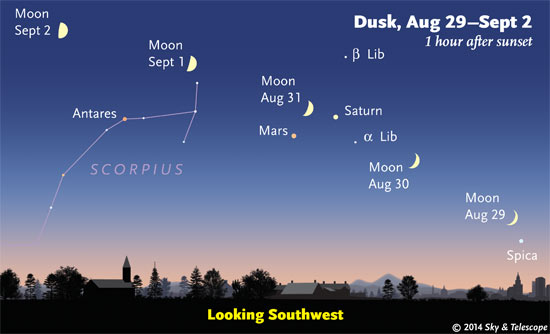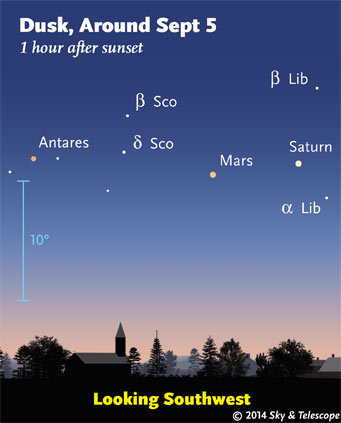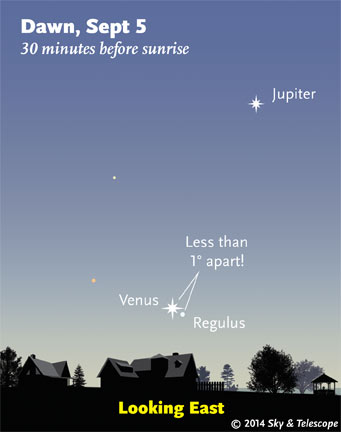Friday, August 29
The Moon is coming back into the evening sky. Look for the waxing crescent low in the west-southwest in twilight, as shown at lower right. Can you make out Spica twinkling beneath it? Binoculars help. Far to their upper left are Saturn and Mars.

Saturday, August 30
The waxing crescent Moon now shines closer to Saturn and Mars, as shown above. Can you see little Alpha Librae in the middle of the narrow triangle they make?
Sunday, August 31
Spot the Moon at dusk with Saturn to its right and Mars to its lower left (for North America).
As the stars come out this week, the first you see may be Arcturus shining high in the west. As the sky gets a little darker, look to its right for the Big Dipper scooping down in the northwest.
Monday, September 1
First-quarter Moon this evening and Tuesday evening (exactly first quarter at 7:11 a.m. Eastern Daylight Time Tuesday morning). It's passing over Scorpius, as shown above.
Tuesday, September 2
The Great Square of Pegasus is well up in the east as soon as nightfall is complete. It's larger than your fist at arm's length and currently stands on one corner. Seen from your latitude at your time, how close is its balance to being perfect?
Wednesday, September 3
Look lower left of the Moon right after nightfall for the Teapot of Sagittarius, tilting and pouring to the right.
Thursday, September 4
In Friday's dawn, use binoculars to help pick up Venus just above the eastern horizon about 30 minutes before sunrise. It's far to the lower left of Jupiter. Can you make out Regulus, less than a hundredth as bright, within 1° of Venus?

Friday, September 5
Saturn, Mars, Delta (δ) Scorpii, and Antares form an equally-spaced ragged line in the southwest at dusk, as shown at right. Delta Scorpii used to be a bit dimmer than Beta above it. Then in July 2000 it doubled in brightness. It has remained bright, with fluctuations, ever since.
Look high above the Moon this evening for Altair.
Saturday, September 6
This evening look to the right of the Moon, by a little more than a fist-width at arm's length, for two faintish (3rd-magnitude) stars: Alpha and Beta Capricorni, one above the other. Alpha is the one on top. With sharp vision, you can barely see that it's double. Binoculars resolve it easily.
And, this is International Observe the Moon night! Zoom in on the map to find an event near you. Or set up your own telescope for the public and add your event to the map so others can find you!
Want to become a better astronomer? Learn your way around the constellations. They're the key to locating everything fainter and deeper to hunt with binoculars or a telescope.
This is an outdoor nature hobby; for an easy-to-use constellation guide covering the whole evening sky, use the big monthly map in the center of each issue of Sky & Telescope, the essential guide to astronomy. Or download our free Getting Started in Astronomy booklet (which only has bimonthly maps).

Once you get a telescope, to put it to good use you'll need a detailed, large-scale sky atlas (set of charts). The standards are the little Pocket Sky Atlas, which shows stars to magnitude 7.6; the larger and deeper Sky Atlas 2000.0 (stars to magnitude 8.5); and once you know your way around, the even larger Uranometria 2000.0 (stars to magnitude 9.75). And read how to use sky charts with a telescope.
You'll also want a good deep-sky guidebook, such as Sue French's Deep-Sky Wonders collection (which includes its own charts), Sky Atlas 2000.0 Companion by Strong and Sinnott, the bigger Night Sky Observer's Guide by Kepple and Sanner, or the beloved if dated Burnham's Celestial Handbook.
Can a computerized telescope replace charts? Not for beginners, I don't think, and not on mounts and tripods that are less than top-quality mechanically (able to point with better than 0.2° repeatability, which means fairly heavy and expensive). As Terence Dickinson and Alan Dyer say in their Backyard Astronomer's Guide, "A full appreciation of the universe cannot come without developing the skills to find things in the sky and understanding how the sky works. This knowledge comes only by spending time under the stars with star maps in hand."
This Week's Planet Roundup
Mercury (about magnitude –0.2) remains quite deep in the sunset, as it always does during its evening apparitions that happen in late summer and early fall. Scan for Mercury with binoculars just above the horizon due west about 20 minutes after sundown.
 Venus (magnitude –3.9) and Jupiter (magnitude –1.8) shine in the east-northeast during dawn. Jupiter is the higher and easier one to spot. Watch far to its lower left for Venus rising as dawn grows bright. The two planets continue drawing farther apart: from 12° apart on August 30th to 20° by September 5th. Jupiter is moving higher, and Venus is gradually sinking lower.
Venus (magnitude –3.9) and Jupiter (magnitude –1.8) shine in the east-northeast during dawn. Jupiter is the higher and easier one to spot. Watch far to its lower left for Venus rising as dawn grows bright. The two planets continue drawing farther apart: from 12° apart on August 30th to 20° by September 5th. Jupiter is moving higher, and Venus is gradually sinking lower.
Use binoculars to catch Regulus less than 1° to Venus's lower left on the morning of September 5th (for North America).
Mars and Saturn, both magnitude +0.6, glow in the southwest at dusk, moving apart after their conjunction last week. They're 4° apart on August 29th and 7° by September 5th. Mars is the one on the lower left early in the week, directly left later. Off to their left are fainter Delta Scorpii, then Antares. Compare all their colors.
Uranus (magnitude 5.7, in Pisces) and Neptune (magnitude 7.8, in Aquarius) are high in the southeast and south, respectively, by midnight. See our Finder charts for Uranus and Neptune online or in the September Sky & Telescope, page 50.
All descriptions that relate to your horizon — including the words up, down, right, and left — are written for the world's mid-northern latitudes. Descriptions that also depend on longitude (mainly Moon positions) are for North America.
Eastern Daylight Time (EDT) is Universal Time (UT, UTC, or GMT) minus 4 hours.
"The universe is full of magical things patiently waiting for our wits to grow sharper."
— Eden Phillpotts, "A Shadow Passes," 1918
 0
0
Comments
You must be logged in to post a comment.